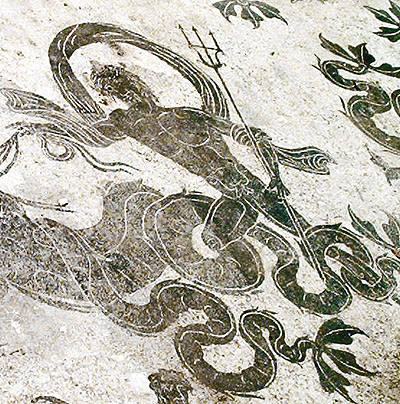Neptunus
Home| Latíné | Deutsch | Español | Français | Italiano | Magyar | Português | Română | Русский | English
Neptunus is a deity encompassing a number of aspects, most notably the sea. His major festival is the Neptunalia, celebrated in Quintilis.
As god of the sea, it is likely that Neptunus was also connected to merchants and to trade generally. He is also found in the first lectisternium, mentioned with Mercurius, which also gives credence to this connection with trade and merchants.
Contents |
Festivals
Neptunalia
The Neptunalia is celebrated a.d. X Kal Sext. ‡. Very little is known about the celebrations that took place on this day, or about the cult which would have celebrated it. About the celebrations of the day, Fowler [1]
says that huts or booths of foliage were set up by the cultores, but this only to protect those who came to worship Neptunus on that day.
Its placement in mid-Summer suggests also the connection with trade, particularly trade by sea, from an astronomical view. In light of the fact that the Moon is at its farthest distance from Earth at this time, waves would have been significantly less than at other times of the year, which would be favourable to any sea-based trade. This would have been an optimal time to propitiate Neptunus in the hopes that he would continue to keep the waves minimised, allowing easier and more successful trade.
This also connects to agriculture. This festival is placed in enough time before the harvest to allow cultores to attempt to propitiate Neptunus such that, when the time comes, farmers will be able to harvest their crops successfully and use them at the markets to trade and barter. The favour of Neptunus would be essential to allow goods from other parts of the Mediterranean to reach Rome and all of Italy safely, something which the agricultural community of early Italy would have desired more than not.
Temples, Priests, and Cult
Just as there is little known about the Neptunalia, there is just as little known about his cult at Rome and throughout Italy. There is no known priest of Neptunus as sponsored by the State (as, for example, the Flamines). It may be assumed that his importance in the early days of Rome may have been minimal, given that he does not carry a flamen, however, this is only a conjecture. It is known, however, that when Neptunus is first seen in ancient literature, he has already taken on the attributes of the Greek Poseidon. From this, it may also be adduced that Neptunus was introduced to ancient Italy from outside cultures, given also the lack of apparent Etruscan reference in his name.
Epigraphy
C.I.L III 13400 Pannonia Superior: Neptuno et Nymphis pro Cassia Clementilla
References
- ↑ Fowler, W. W. The Roman Festivals of the Period of the Republic: An introduction to the study of the religion of the Romans (ISBN 1402148577)
